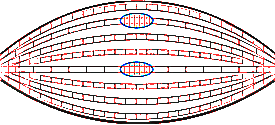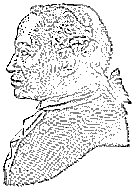Information about trigger points
What is a trigger point?
![Trigger point in muscle fibres [Trigger point in muscle fibres]](../pictures/trp-fibres.gif)

A trigger point is a knot in a band of muscle tissue, in which several fibres are in a state of permanent contraction. Typically, a trigger point is about the size of a pea, but it can also be as small as a pin-head. A trigger point keeps a muscle continuously under tension. In most people dozens of trigger points can be found and often you do not notice them at all in all day life.
How do trigger points develop?
The most frequent cause for a trigger point to develop is the overuse or overload of a muscle. Often, stress is a contributing factor. A trigger point is the last resource available to the body to contract a muscle when there is no energy left. Another frequent cause is tissue damage. By tensing certain muscles, the body tries to protect the damaged spot. The brain infers from messages from the nervous system, that something has been damaged. Unfortunately those messages are not always reliable. Therefore, trigger points can also be the consequence of a disturbance in the nervous system. A muscle can also develop trigger points if the motor nerve that supplies it is dysfunctional. Trigger points can also induce new trigger points themselves, as explained later on this page. It is not always possible to find out why a trigger point has developed. Sometimes trigger points continue to exist when the reason for them has already disappeared. However, as long as the cause remains, trigger points will return after their treatment.
Trigger points and pain
Trigger points can arise from pain and can cause pain themselves. As a rule, the pain is felt at a distance from the trigger point. The trigger point itself hurts only when you firmly press or squeeze it. As an example, the following drawing illustrates the pain pattern of a certain trigger point in the front of the neck. The black cross is the position of the trigger point, the red area and the red spots are possible places where the trigger point can send its pain. This is one of the body's worst trigger points, because it is situated so close to a big nerve bundle. Fortunately trigger points are usually latent, meaning that they shorten the muscle in which they reside but do not refer pain. On the other hand, an active trigger point radiates pain and can baffle patients as well as physicians, because nothing special can be found at the painful place itself.
![Scalenus trigger point [Scalenus trigger point, Travell & Simons Vol. 1 Figure 20.1A]](../pictures/travell_bd1_fig20.1_a.gif)
Other effects of trigger points
Because they disturb the balance between the muscles performing a movement, trigger points can lead to misalignment and incorrect movement patterns of limbs and therefore wear and tear of joints. The tension in muscles harbouring trigger points can overload other muscles and in this way induce new trigger points. New trigger points can also arise when the brain interprets the pain emitted by the primary trigger point as tissue damage. Trigger points can disturb the functioning of the many receptors in muscles that, for example, report the position of body parts to the brain (proprioception) or the amount of tension in the muscle. In this way, trigger points can make you trip or drop things.
The tension caused by trigger points in muscles, tendons and membranes can lead to constriction of nerves, blood vessels or lymph vessels. This can lead to nerve pain or swelling. Trigger points can thus also affect autonomic functions in the body, such as digestion, circulation, sweat secretion, sense of balance and vision. A trigger point can also cause symptoms in the skin, like itching, burning, redness or goosebumps; often in the area where it typically radiates its pain.
Via the nervous system, trigger points can in principle influence every bodily function, but that does not mean that every symptom or disease is always caused by trigger points. Nevertheless, it is always worthwhile to try out trigger point therapy, provided there is no indication of a serious injury or disease that would require immediate medical intervention: A trigger point treatment carried out by a professional is affordable, safe and without adverse side effects.
Trigger points and fibromyalgia
Fibromyalgia and trigger points are different conditions, although they often coexist and interact. Fibromyalgia is the term given to a family of illnesses that have in common central nervous system sensitization. Fibromyalgia amplifies pain, and it can make the central nervous system interpret normally non-painful stimuli as pain. Trigger points and fibromyalgia are both a reaction of the body to an overload of the nervous system. The pain generated by trigger points will make the fibromyalgia still worse. Everything that quiets down the nervous system, will ease both the fibromyalgia and the trigger points. You can find more on the relation between fibromyalgia and trigger points on Devin Starlanyl’s website and in her book.
Treatment of trigger points
![Kant [Kant]](../pictures/kant.gif)

In the beginning of my career as a massage therapist, I treated all trigger points I found and then hoped that they would stay away. Nowadays, I try in the first place to trace and treat the causes. A trigger point is a way in which the body adapts to a disturbing factor. For instance, in case of a head forward posture, trigger points in the back of the neck help to prevent the head from falling further forward. When a peripheral nerve is pinched, trigger points limit the motion in the limbs, so that the nerve cannot be damaged by excessive lengthening. In these examples, the treatment of the trigger points without treating their cause will result at best in a temporary relief of the symptoms, but at worst in later aggravation of the symptoms or even in new complaints. However, after treatment of their causes, many trigger points resolve by themselves.
The cause of a trigger point can also be another trigger point. When a client comes to a therapist, the trigger points usually have spread already in a long chain across the body. Treatment of a single trigger point in the chain makes no sense. Without treatment of the whole chain, the trigger point will return in no time.
If it is not possible to do something about the cause and the trigger point does not produce pain or other symptoms, it is generally the best to leave it alone. However, when the trigger point does cause symptoms and it is not possible to remove the disturbing factor, there are several possible choices:
- treating the trigger point and asking the client to return regularly for a new treatment;
- treating the trigger point and teaching the client its self-treatment too;
- treating the trigger point and in addition giving the body an option to adapt itself in a better way to the disturbing factor.
My preference is the last choice, although it is not always the easiest one. For instance, if sitting in front of a computer causes trigger points, I can aid the client in finding a better posture. For this purpose, it is necessary to release all tension in muscles and connective tissue (fascia) that hinder the body from assuming and keeping up that better posture. Of course, the client should then really use that better way of sitting, without falling back into the old posture.
A wrong posture or movement pattern can also be maintained by factors outside the body. For instance computer screens, office chairs, car seats, multifocal or progressive lenses, running shoes and orthotic insoles can have been adjusted or selected such that they feel comfortable in the old posture. When these devices are not readjusted or replaced, it will be impossible to maintain a new posture or movement pattern. Therefore, the success of a trigger point treatment depends also on how well the client recognizes these external factors and is willing or has the possibility to do something about them.
There are many ways to deactivate trigger points. Generally a therapist will select the applied technique in accordance with his or her education:
- physicians prefer to inject an anaesthetic into the trigger point;
- acupuncturists stimulate the trigger point by insertion of an acupuncture needle (dry needling);
- massage therapists and physiotherapists are usually more familiar with compression techniques, similar to acupressure;
- the Swiss approach to trigger point therapy combines local trigger point massage with treatment of the whole connective tissue sheath of the muscle in which the trigger point resides;
- indirect techniques aim to bring the tissue that the trigger point is trying to ‘protect’ into a state of maximum relaxation. In this way, the brain gets the message that the trigger point is no longer needed.
Nowadays, I usually start with indirect techniques. A major advantage of indirect techniques is that they do not hurt. This is why they are the first choice in case of a hypersensitive nervous system, for example fibromyalgia. Another advantage is that they are applicable to trigger points that cannot be safely reached with fingers or a needle. But when chronic overloading has changed the structure of the fascia, direct techniques are also needed, in particular restoring the elasticity of the fascia. Direct techniques can hurt, but when carried out correctly, they feel relieving at the same time.
Regardless of the way in which the trigger point is treated as a symptom, in my view the most important part of trigger point therapy is to trace and — to the extent possible — treat the cause.
Self-treatment of triggerpoints
Pressure point massage, whether combined with small movements or not, is the simplest form of self-treatment. But be careful with it! If you press hard enough, every spot on the body hurts. But not every tender spot in the body is a trigger point. Trigger points love pressure, but more sensitive structures in the body, such as nerves, can become irritated or even damaged by too much pressure. To treat trigger points safely and effectively, you need to have knowledge of anatomy. You best obtain this by reading a book on the self-treatment of trigger points. I myself learnt the first principles of treating trigger points – even before my training as a massage therapist – from The Trigger Point Therapy Workbook. I can still recommend that, but many other good books were written on the subject later. Nowadays, people are used to all information being free, but money in your health is well invested. Make sure you buy a book meant for laymen. Books written for professionals presuppose a lot of prior knowledge to understand and safely perform the techniques described.

